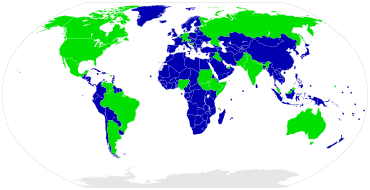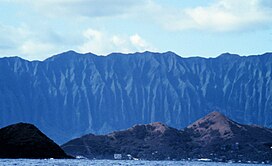연합국
Federated state연방국가(주, 도, 지역, 주, 주, 토지, 주지사, 주, 토후국 또는 국가라고도 함)는 [1]연방을 구성하는 영토 및 헌법 공동체이다.이러한 주들은 주권력이 연방정부와 중앙정부 또는 연방정부 사이에 분할되었기 때문에 완전한 주권력을 가지고 있지 않다는 점에서 완전한 주권국가들과 다르다.중요한 것은 연방국가들은 국제법의 실체로서의 지위를 갖지 못한다는 것이다.대신, 연방은 국제법의 [2]목적상 주권국가이다.연방 국가는 특정 연방의 헌법 구조에 따라 정의된 지리적 영역에 대해 다양한 수준의 입법, 사법 및 행정적 관할권을 가질 수 있으며 지역 정부의 한 형태입니다.
어떤 경우, 연방은 다른 주권 주체(가장 일반적으로 식민지 권력)[A]의 독립 또는 종속된 영토인 정치적 실체의 연합에서 만들어진다.다른 경우, 연방 주(州)는 이전에 단일 주(州)[B]였던 행정 구역에서 생성되었습니다.일단 연방헌법이 만들어지면 연방정부와 지역권력 간의 관계를 지배하는 규칙은 국제법이 아닌 헌법의 일부가 된다.
연방 헌법이 있는 국가에서는 중앙 정부와 구성 요소 주 사이에 권력 분담이 있습니다.이들 단체(주, 주, 카운티, 주, 랜더 등)는 부분적으로 자치되며 연방마다 실질적으로 다른 [C]헌법상 보장된 자치권을 부여받는다.분권형식의 형태에 따라 연방의 입법권은 연방정부에 의해 무시되거나 거부될 수 있다.연방정부와 지역권력 간의 관계를 지배하는 법률은 국가 또는 연방헌법과 존재하는 경우 주헌법을 통해 개정할 수 있다.
내부 정치의 관점에서, 연방 주들은 공화정 또는 군주정치의 형태를 가질 수 있다.공화주의 형태(연방 공화국)는 보통 미국의 주(state) 또는 공화국(republic)으로 불린다.
연맹별 선거인단 목록
아래 표의 "연방 단위"는 연방 헌법 시스템에 내재된 정부 권한을 가지며, "기타 단위"는 연방 정부에 의해 권한을 위임받거나 연방 정부에 의해 직접 관리된다.
See also
- Associated state
- Federal district
- Federal territory
- Federation
- List of administrative divisions by country
- List of autonomous areas by country
- List of sovereign states
- Supranational union
Notes
- ^ Examples are Australia and the United States.
- ^ This occurred in Belgium in 1993. The Belgian regions had previously devolved powers.
- ^ For instance, Canadian provinces and Swiss cantons possess substantially more powers and enjoy more protection against interference and infringements from the central government than most non-Western federations.
- ^ a b c d e f g h i j k l m n o p q r Federal capital district, region or territory.
- ^ Flanders and Wallonia are subdivided into five provinces each, which are mandated by the Constitution of Belgium. Provincial governance is the responsibility of the regional governments.
- ^ The communities and regions of Belgium are separate government institutions with different areas of responsibility. The communities are organized based on linguistic boundaries, which are different from regional boundaries.
- ^ a b c d e f g autonomous area
- ^ The Brazilian federal district has a level of self-ruling equal to the other main federal units.
- ^ Article 18 of the 1988 Brazilian Constitution treats the municipalities as parts of the federation and not simply dependent subdivisions of the states.
- ^ a b c d e f g h i j Sovereignty over territory actively disputed by another sovereign state or the international community.
- ^ Adopted constitution accommodates existing regional governments, with the ultimate number and boundaries of the Federal Member States to be determined by the House of the People of the Federal Parliament.
References
- ^ The Australian National Dictionary: Fourth Edition, pg 1395. (2004) Canberra. ISBN978-0-19-551771-2.
- ^ Crawford, J. (2006). The Creation of States in International Law. Oxford, Clarendon Press.
- ^ Daniel, Kate; Special Broadcasting Service Corporation (2008). SBS World Guide: The Complete Fact File on Every Country, 16th ed. Prahran, Victoria, Australia: Hardie Grant Books. p. 827. ISBN 978-1-74066-648-0. p26. Archived from the original on 2021-07-27. Retrieved 2020-11-11.
- ^ SBS World Guide 2008, p38
- ^ SBS World Guide 2008, p46
- ^ SBS World Guide 2008, p74
- ^ "Decision of the Constitutional Court of the Federation of Bosnia and Herzegovina on Canton 10". Constitutional Court of the Federation of Bosnia and Herzegovina. Archived from the original on 31 July 2020. Retrieved 3 February 2020.
- ^ SBS World Guide 2008, p101
- ^ SBS World Guide 2008, p132
- ^ SBS World Guide 2008, p239
- ^ SBS World Guide 2008, p275
- ^ SBS World Guide 2008, p328
- ^ SBS World Guide 2008, p346
- ^ SBS World Guide 2008, p460
- ^ SBS World Guide 2008, p481
- ^ SBS World Guide 2008, p486
- ^ SBS World Guide 2008, p537
- ^ SBS World Guide 2008, p549
- ^ SBS World Guide 2008, p600
- ^ "Chapter 3. The Federal Structure: Article 65". The Constitution of the Russian Federation. Archived from the original on 2018-12-25. Retrieved 2010-07-11.
- ^ "The Federal Republic of Somalia – Harmonized Draft Constitution" (PDF). Federal Republic of Somalia. Archived from the original (PDF) on 20 January 2013. Retrieved 2 August 2012.
- ^ "Guidebook to the Somali Draft Provisional Constitution". Archived from the original on 20 January 2013. Retrieved 2 August 2012.
- ^ a b Mednick, Sam (2020-02-23). "After 6 years of war, will peace finally come to South Sudan? News". Al Jazeera. Archived from the original on 2020-08-20. Retrieved 2021-12-07.
- ^ SBS World Guide 2008, p687
- ^ "Sudan: Protocol on the resolution of Abyei conflict – Sudan". ReliefWeb. Archived from the original on 2021-10-21. Retrieved 2021-10-21.
- ^ SBS World Guide 2008, p700
- ^ SBS World Guide 2008, p760
- ^ SBS World Guide 2008, p774
- ^ SBS World Guide 2008, p798



